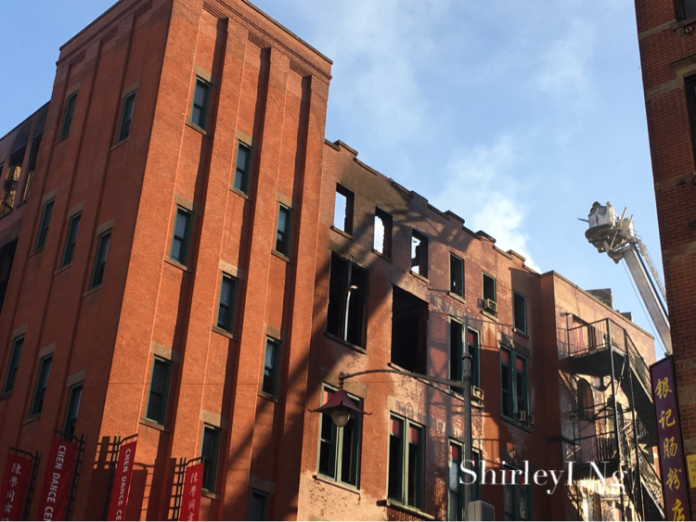Local residents and activists in New York City’s Chinatown are outraged over new developments to demolish a historic community center on 70 Mulberry Street, which suffered severe damages in a fire on January 23.
The fire, which reportedly started on the fourth floor of the five-story building, displaced the numerous community organizations based in the community center, including the Chinese American Planning Council, Chinatown Manpower Project, Chen and Dancers, Museum of Chinese in America and the United East Athletics Association, according to AsAmNews.
For many in Manhattan’s Chinatown, the community center is a cornerstone of cultural significance with a rich history of over 125 years.
On the following day after the fire, New York City Mayor Bill De Blasio visited Chinatown to examine the fire damage alongside NYC Council Member Margaret Chin and New York State Assembly Member Yuh-Line-Niou, AsAmNews reported in January.
“This is literally a pillar to the community. A painful moment on the eve of a joyous celebration,” De Blasio remarked, referring to the Lunar New Year. “This is a horrible blow to the community, there is still fire operations going on. Once those are concluded the buildings department will go in again to establish whether the building is safe enough for people to enter and get their possessions out.”
He called the community center, which is owned by the city, a “beautiful historic building.”
“We will restore it. The city is committed in bringing this building back to life,” the mayor added.
However, Chinatown residents are now calling the mayor’s statement ‘empty words’, expressing anger over the city’s decision to tear down the historic building with little input.

“He’s really backtracking on his words,” Karlin Chan, a local advocate, told WPIX. “You can’t come into the community and tell us you’re going to knock it down and not show us any plans for the future building, like maybe how they’re going to incorporate some of those architectural designs.”
June Hee, a board member of United East Athletics Association, echoed similar sentiments.
“The decision was made without our feedback,” Jee told NBC . “We were mostly hearing things off the street.”
Local residents also told NBC that “the city didn’t provide updates on the planning process until May 14, when it announced at a community board meeting that the entire building would be torn down and replaced.”
On May 26th, the nonprofits housed in the community center before the fire issued a collective letter to “present one unified…voice regarding the future of 70 Mulberry especially in light of our shared concern that there may be an escalating level of conversation regarding the 70 Mulberry Street site as witnessed at the Community Board 3 Land Use meeting on May 14, 2020.
The letter signatories also added that “it is imperative to maintain and incorporate aspects of the history of the 70 Mulberry in the new design and outfitting.”
According to NBC , Joseph Wagner, the chief engineer at the Department of Citywide Administrative Services, said during the meeting on May 14 that the damage to the building was too severe to be restored.
Wagner reported that the demolition process has already begun and is anticipated to finish by October, but added that “the city remains committed to reinstating the five tenant organizations in the new property.”
“There really isn’t anything I can see that you can save to reuse again,” Wagner said at the meeting, believing that the construction cost of restoring exceeds that of a full demolition.
However, not all agree with Wagner’s assessment.
Kerri Culhane, an architectural historian who has extensively studied Manhattan’s Chinatown, told NBC that “there’s never been an independent analysis of the building and the preservation opportunity.”
Culhane further added that Wagner, who isn’t allegedly trained in preservation, did not seem to be “familiar with or open to the possibilities of restoring historic architecture.”
Built in 1893, the community center housed Public School 23, the first school designed by acclaimed architect Charles B. J. Snyder. According to the Gothamist, over the next eight decades, generations of children frequented the building, where they were able to receive primary education. In 1975, the space then converted into a community center, with various organizations providing a host of services and resources. Until the fire, the building was reportedly the only city-owned property in Chinatown occupied entirely by nonprofits.
“Within this one location you have a range of services for a lot of people,” Jee of United East Athletics Association said. “When you break that apart, we lose the anchor that people simply gravitate to.”
AsAmNews has Asian America in its heart. We’re an all-volunteer effort of dedicated staff and interns. Check out our new Instagram account. Go to our Twitter feed and Facebook page for more content. Please consider interning, joining our staff, or submitting a story.


